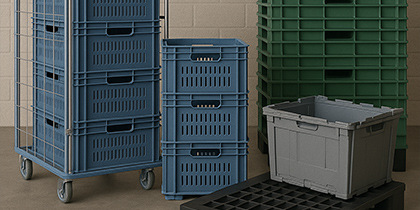Returnable packaging is rapidly gaining ground in sectors such as logistics, food and retail. This approach, in which packaging circulates multiple times in the chain instead of being discarded after one use, reduces waste and provides control over costs. According to Verpact (August 2023), 88% of all packaging was recycled or reused in the Netherlands in 2022. The total weight of reusable packaging in circulation is now equal to that of disposable packaging, indicating wide acceptance of these systems in various sectors.
In this article you will read how returnable packaging will help your organization reduce packaging costs, meet circular targets and be prepared for European regulations such as the PPWR.
Returnable packaging: what is it?
Returnable packaging refers to packaging that is not thrown away after use, but returned to the shipper or producer for reuse. It often involves sturdy, reusable materials such as plastic bins, crates, pallets or containers-but also lighter solutions such as resealable bags in the retail or fashion industry.
These packages are designed for longevity, withstand multiple transportation cycles and are often equipped with tracking mechanisms to efficiently organize return logistics.
Key features of returnable packaging:
- Reusable: capable of tens to hundreds of cycles.
- Strong and hard-wearing: able to withstand intensive use.
- Traceable: with barcodes, RFID or IoT tracking.
- System-oriented: part of a closed return chain.
Why deploy returnable packaging?
For organizations active in logistics, retail or manufacturing, returnable packaging offers clear benefits. Not only for reducing waste, but also financially, organizationally and strategically. We have listed the most important benefits for you:
Less packaging waste, more control
Returnable packaging helps to structurally reduce packaging waste. Because the same packaging is used several times, there is less need for disposable packaging throughout the chain. This reduces the pressure on raw materials and the consumption of new packaging. Moreover, traceability makes it possible to track packaging in real time. This gives more control over packaging flows and ensures more efficient logistics processes.
Lower long-term costs
The purchase cost of reusable packaging is often higher than that of disposable packaging. However, this investment pays for itself quickly. However, handling, storage and administration become more efficient because reusable packaging is often standardized and fits better into logistics processes.
Less dependence on new raw materials
By keeping packaging longer in the chain, you reduce your dependence on raw materials such as plastic, paper or wood. This not only reduces the ecological impact of your packaging, but also makes your organization more resilient to price fluctuations and supply problems, for example in case of raw material shortages.
Practical applications of returnable packaging
Returnable packaging is now widely used in various sectors, including logistics, retail, production and healthcare, where, for example, reusable containers are used for the safe transport of medical devices. Here are some concrete examples:
Logistics: efficient return flows
Logistics service providers use reusable crates, roll cages and pallets to transport goods between distribution centers, suppliers and retailers. These packages return after delivery, are cleaned or directly reused.
Benefit: less handling, less waste on the shop floor, and consistent quality in the supply chain.
Retail: closed chains and less waste
In supermarkets, reusable packaging is used for AGF products, meat products and non-food. Think collapsible crates that are returned to the supplier.
Benefit: better protection of products, less packaging material and less waste in stores.
Production: chain cooperation around packaging
Manufacturers working with suppliers deploy reusable transport packaging, often customized. Think of ESD-safe containers in the electronics industry or heavy-duty containers in the automotive industry.
Benefit: cost savings in transportation, faster processing and less risk of component damage.
Challenges and regulations surrounding returnable packaging
Although the advantages of returnable packaging are obvious, implementation requires careful preparation. Especially in the areas of logistics, system design and legislation, there are points of attention:
Logistical complexity
A working return process requires clear agreements, reliable tracking and sufficient scale. Without good returns management, there is a risk of loss, downtime or inefficiency.
Solution: work with established partners in the chain, automate tracking with smart tools and start on a small scale.
Investment and organization
Reusable packaging requires a different way of thinking: you become the temporary owner of your packaging. This requires investment, management and storage capacity.
Solution: look at returnable packaging as a strategic part of your chain. Think in terms of total cost of ownership, not unit price.
European legislation: the PPWR
The Packaging and Packaging Waste Regulation (PPWR), a new EU regulation in preparation, makes returnable packaging even more topical. This legislation promotes reuse and sets requirements for the reusability of packaging.
Key pillars from the PPWR:
- Reduce: less packaging material and less variation.
- Reuse: obligation to use reusable systems.
- Recycle: clear requirements for material recycling.
Returnable packaging links directly to the first two objectives: Reduce and Reuse. Using packaging more often and using less material eliminates the need to recycle again and again.
Ready to deploy returnable packaging?
Returnable packaging offers companies in logistics, retail and manufacturing the opportunity to control costs and prepare for stricter regulations, such as the upcoming PPWR regulation.
Do you want to know how the new packaging legislation (PPWR) will impact your organization? And how to get started with returnable packaging and smart return systems?
Stay up todate
Want to stay up to date on all new developments? Follow us onLinkedIn, listen to the podcast 'Grondstof tot nadenken' or subscribe to the newsletter. Are you curious about what Milgro can do for your operations and waste process? Then get in touch.















